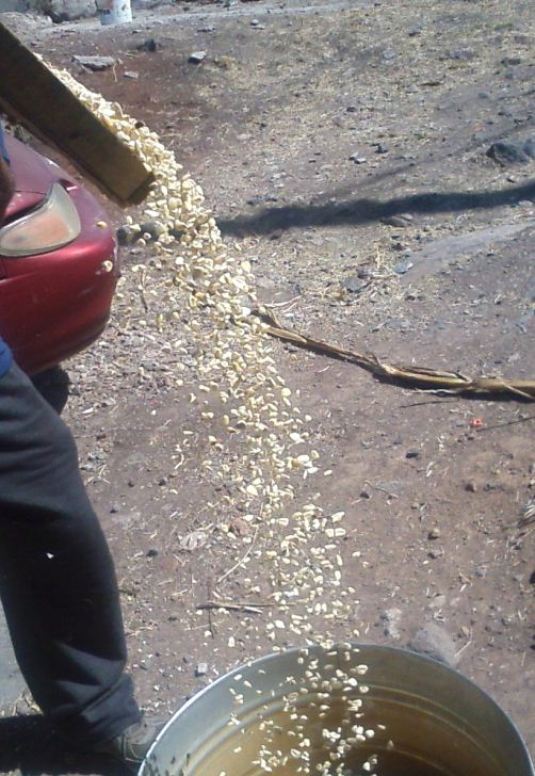
The word pozole, also spelled pozolli or posole, means hominy and is the name of yet another traditional Mexican dish that predates the Spanish conquest. The name comes from the Náhuatl word tlapozonalli which means boiled or fluffy, referring to the corn, or the Cahíta word posoli which means cooked corn.
There are three typical versions. Just like the Mexican flag, there is a red, a white and a green pozole.
Pozole blanco (white) and Pozole verde (green) are often made with chicken rather than pork. The green color comes from the tomatillo salsa added and the red from the chile salsa used.
The soup is garnished with chopped lettuce, onion, cabbage, oregano, radish, avocado, cheese, salsa, chile powder, sour cream and a squirt of lime. Typically these are left out for each diner to add as he or she desires. Instead of tortillas, tostadas are served with this soup.
After you’ve tried this delicious soup, it’s no wonder that the Aztec served pozole only for special occasions, a tradition that continues to this day. (See Christmas Eve, Las Posadas)
The Aztec typically used the meat from the tepezcuintle (a large rodent) and cacahuazintle (large grained white corn) to make pozole.
However, there was also an extra special version made from the meat of human sacrifices.

This ceremonial pozole was carefully prepared, cooked and shared among participants as part of the holy ritual. The diners were typically the highest level priests and the emperor. Commoners were prohibited this sacred version of pozole. There was a highly symbolic significance to this meal. It was a representation of the duality of life, beginning (the Aztec believed themselves to be the people of the corn) and end (death as the final product). It was considered a holy communion ritual, allowing the those that partook to experience a connection with the gods.

One of these high holy days that called for the special pozole was the festival Ecalcoaliztli, the meal of Ecatl (meaning cooked corn) in honor of Quetzalcoatl.
Apparently, human meat tasted enough like pork that when pigs were introduced in the diet by the Spaniards, it became the meat of choice for pozole. As there was no ceremony involved, pozole was then available for everyone to eat.

Although I prefer pozole blanco, my husband loves the pozole rojo. For a time, we sold pozole on Saturdays. (See Failing at your own business–Pozole) My sister-in-law T makes her pozole with pig feet.

So how do you make pozole, using pork or chicken rather than human mean, of course?
The corn is prepared in the same fashion as the tortilla and tamal masa. My husband often uses red corn rather than white in his pozole, but the procedure is the same.
The chiles are opened and deseeded, boiled until soft (about 30 minutes), then blended with garlic and salt. My husband sometimes adds a little bread or flour to thicken it. Strain the chile mixture, discarding the solid part.
Brown the pork. Sautee garlic and onion pieces. Add the pork, garlic and onion to a chicken broth and water mixture. Add oregano, a whole garlic, bay leaf, salt and the strained chile. Bring to a boil, then reduce to a simmer. Cover and cook about 3 hours. Add the hominy and simmer until the pork falls apart, about another hour. Remove the bay leaf and whole garlic. If the pozole is too thick, add a little more water or broth.
Garnish as desired.

Don’t treat someone like pozole who treats you like instant noodles.
And to finish off, how’s this Mexican saying? “No trates como pozole a quien te trata como maruchan.” Don’t treat someone better than they treat you.
The Write Tribe Festival of Words #5












OMG so nice, we know so less about them!
LikeLiked by 1 person
Interesting.
LikeLiked by 1 person
Love this post.!! Thank you for the recipe. I am going to try to make this delicious meal one day 🙂
LikeLiked by 1 person
i”m going to be on the lookout for an authentic version of the pozole soup ( not the one with human or rat flesh). Looks delicious. I find it fascinating that each of the foods have such a spiritual background.
LikeLiked by 1 person
Quite a few Mexican stores in the US sell canned pozole–of course it’s not usually vegetarian. You can buy the hominy and make it yourself though!
LikeLiked by 1 person
Great post! So fascinating and delicious to read. have a lovely word festival week~
LikeLiked by 1 person
Must try it. http://www.theadventuresofdostortas.com
LikeLiked by 1 person
Let me know how it turns out!
LikeLike
That looks like a lot of work – but anything done well is worth the work. Pinned!
LikeLiked by 1 person
They used to use human meat 😱 wow all this sounds so fascinating and intriguing… I had never heard about this before. It wonderful to read something so new to me 🙂 thank you for visiting my blog 🙂
LikeLiked by 1 person
I haven’t of this dish ever and then human meat? Those pictures freaked me out. A lot historical significance I believe. Thanks for sharing!
LikeLike
Another interesting post exploring the history of food….although human sacrifices is too much to digest…..!
LikeLiked by 1 person
Apparently it takes just like pork!
LikeLiked by 1 person
Apparently it tastes just like pork!
LikeLike
Pingback: Where’s the beef? | Surviving Mexico
Pingback: How to Stay Warm in Rural Mexico | Surviving Mexico
Pingback: Finding Something to Look Forward to (with Herbs) | Surviving Mexico